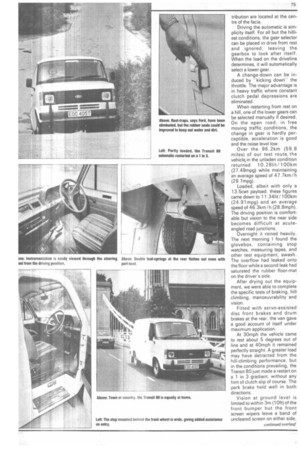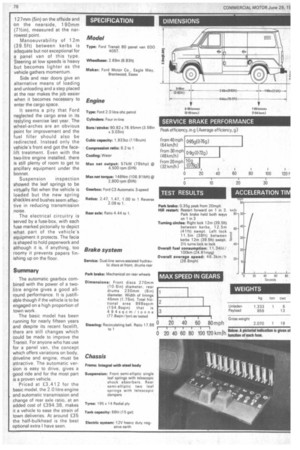Auto Transit is handy hit towns
Page 76

Page 77

Page 78

If you've noticed an error in this article please click here to report it so we can fix it.
FORD'S C3 automatic gearbox has been used for some years on the Granada car range. We tested a Transit 80 with it fitted this week. The low-compression two-litre engine has been developed to use lower-priced twostar petrol.
With 18 door options to choose from, it is not difficult to find a Transit that is a little dif ferent from the others, and for practical day-to-day work this Ford panel van takes a lot of beating. Driver access to the front of the vehicle is unob structed. Placed behind the front axle, the step is wide enough and seems to be just the right height to be a help on entry.
The cargo capacity of 5.4cum (193cuft) is reduced by the rear wheel-arches which en croach into the floor space. Their presence, however, give the 80 a low platform height of 0.6m (2ft) when unladen. Nevertheless if they were flat topped, better use could be made of the van's capacity. The large side panels, supported by vertical ribs, flexed only a little, and there was little body boom.
The single rear door lifted up, well above head height, to pro vide a large opening free of impediment on all but the top edge where the door hinges restricted the height slightly.
However, any item which can pass through the door and bet ween the wheel arches can be moved forward to the floor-toroof bulkhead. This is located to one side behind the driving seat and is a bolt-in extra which I for one, would like to see included as a standard item.
Our test vehicle was also equipped with a hinged side loading door which opened for ward to be retained by a clip mounted on the front passenger door. Located at the front of the cargo compartment, it provides for kerbside loading.
The seats are cloth covered and the driver's seat had vertical adjustment in addition to conventional forward and rearward adjustment.
An inclined steering column gave the steering wheel a com fortable rake. Two pedals only, throttle and brake, ensured an uncluttered floor area. The ser vice brake pedal is twice the size of the one provided on the manual gearbox models. The handbrake lever is positioned in the centre of the vehicle close to the driving seat.
The heater, with outlets to both footwells and to the screen for demisting, is assisted by a noisy two-speed fan. Controls governing temperature and dis tribution are located at the centre of the facia.
Driving the automatic is simplicity itself. For all but the hilli est conditions, the gear selector can be placed in drive from rest and ignored, leaving the gearbox to look after itself. When the load on the driveline determines, it will automatically select a lower gear.
A change-down can be induced by -kicking downthe
throttle_ The major advantage is in heavy traffic where constant clutch pedal depressions are eliminated.
When restarting from rest on a hill, one of the lower gears can be selected manually if desired, On the open road, in free moving traffic conditions, the change in gear is hardly perceptible, acceleration is good and the noise level low.
Over the 96.2km (59.8 miles) of our test route, the vehicle, in the unladen condition returned 10,281it / 100km (27.49mpg) while maintaining an average speed of 47.7km /h (29.7mpg).
Loaded, albeit with only a 13.5cwt payload, these figures came down to 11.341it /100km (24.91 mpg) and an average speed of 46.3km /h (28.8mph). The driving position is comfortable but vision to the near side becomes difficult at acuteangled road junctions.
Overnight it rained heavily. The next morning I found the glovebox, containing stop watches, measuring tapes, and other test equipment, awash. The overflow had leaked onto the floor while a second leak had saturated the rubber floor-mat on the driver's side.
After drying out the equipment, we were able to complete the specific tests of braking, hill climbing, manoeuvrability and vision.
Fitted with servo-assisted disc front brakes and drum brakes at the rear, the van gave a good account of itself under maximum application.
At 30mph the vehicle came to rest about 5 degrees out of line and at 40mph it remained perfectly straight. A greater load may have detracted from the hill-climbing performance, but in the conditions prevailing, the Transit 80 just made a restart on a 1 in 3 gradient, without any hint of clutch slip of course. The park brake held well in both directions.
Vision at ground level is limited to within 3m (1 Oft) of the front bumper but the front screen wipers leave a band of uncleared screen on either side,
127mm (Sin) on the offside and on the nearside, 1 90mrn (71/2in), measured at the narrowest point.
Manoeuvrability of 12m (39.51t) between kerbs is adequate but not exceptional for a panel van of this type. Steering at low speeds is heavy but becomes lighter as the vehicle gathers momentum.
Side and rear doors give an alternative means of loading and unloading and a step placed at the rear makes the job easier when it becomes necessary to enter the cargo space.
It seems a pity that Ford neglected the cargo area in its restyling exercise last year. The wheel-arches are an obvious point for improvement and the fuel filler should also be redirected. instead only the vehicle's front end got the facelift treatment. Even with the two-litre engine installed, there is still plenty of room to get to ancillary equipment under the bonnet.
Suspension inspection showed the leaf springs to be virtually flat when the vehicle is loaded but the new spring shackles and bushes seem effective in reducing transmission noise.
The electrical circuitry is served by a fuse-box, with each fuse marked pictorially to depict what part of the vehicle's equipment it protects. The facia is shaped to hold paperwork and although it is, if anything, too roomy it prevents papers finishing up on the floor.
$ummary
The automatic gearbox combined with the power of a twolitre engine gives a good allround performance. it is justifiable though if the vehicle is to be engaged on a high proportion of town work.
The basic model has been running for nearly fifteen years and despite its recent facelift, there are still changes which could be made to improve the Transit. For anyone who has use for a panel van, the concept which offers variations on body, driveline and engine, must be attractive. The automatic version is easy to drive, gives a good ride and for the most part is a proven vehicle.
Priced at £3,412 for the basic model, the 2.0 litre engine and automatic transmission and change of rear axle ratio, at an added cost of £394.38, makes it a vehicle to ease the strain of town deliveries. At around £35 the half-bulkhead is the best optional extra I have seen.
































































































































